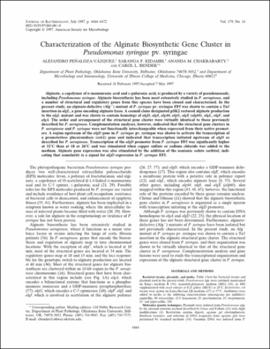| dc.contributor.author | Penaloza-Vazquez, Alejandro | |
| dc.contributor.author | Kidambi, Saranga P. | |
| dc.contributor.author | Chakrabarty, Ananda M. | |
| dc.contributor.author | Bender, Carol L. | |
| dc.date.accessioned | 2015-10-16T20:47:41Z | |
| dc.date.available | 2015-10-16T20:47:41Z | |
| dc.date.issued | 1997-07 | |
| dc.identifier | okds_Bender_JB_1997-07.pdf | |
| dc.identifier.citation | Penaloza-Vazquez, A., Kidambi, S. P., Chakrabarty, A. M., & Bender, C. L. (1997). Characterization of the alginate biosynthetic gene cluster in Pseudomonas syringae pv. syringae. Journal of Bacteriology, 179(14), 4464-4472. https://doi.org/10.1128/jb.179.14.4464-4472.1997 | |
| dc.identifier.uri | https://hdl.handle.net/11244/19767 | |
| dc.description.abstract | Alginate, a copolymer of D-mannuronic acid and L-guluronic acid, is produced by a variety of pseudomonads, including Pseudomonas syringae. Alginate biosynthesis has been most extensively studied in P. aeruginosa, and a number of structural and regulatory genes from this species have been cloned and characterized. In the present study, an alginate-defective (Alg2) mutant of P. syringae pv. syringae FF5 was shown to contain a Tn5 insertion in algL, a gene encoding alginate lyase. A cosmid clone designated pSK2 restored alginate production to the algL mutant and was shown to contain homologs of algD, alg8, alg44, algG, algX (alg60), algL, algF, and algA. The order and arrangement of the structural gene cluster were virtually identical to those previously described for P. aeruginosa. Complementation analyses, however, indicated that the structural gene clusters in P. aeruginosa and P. syringae were not functionally interchangeable when expressed from their native promoters. A region upstream of the algD gene in P. syringae pv. syringae was shown to activate the transcription of a promoterless glucuronidase (uidA) gene and indicated that transcription initiated upstream of algD as described for P. aeruginosa. Transcription of the algD promoter from P. syringae FF5 was significantly higher at 32°C than at 18 or 26°C and was stimulated when copper sulfate or sodium chloride was added to the medium. Alginate gene expression was also stimulated by the addition of the nonionic solute sorbitol, indicating that osmolarity is a signal for algD expression in P. syringae FF5. | |
| dc.format | application/pdf | |
| dc.language | en_US | |
| dc.publisher | American Society for Microbiology | |
| dc.rights | This material has been previously published. In the Oklahoma State University Library's institutional repository this version is made available through the open access principles and the terms of agreement/consent between the author(s) and the publisher. The permission policy on the use, reproduction or distribution of the material falls under fair use for educational, scholarship, and research purposes. Contact Digital Resources and Discovery Services at lib-dls@okstate.edu or 405-744-9161 for further information. | |
| dc.title | Characterization of the alginate biosynthetic gene cluster in Pseudomonas syringae pv. syringae | |
| osu.filename | okds_Bender_JB_1997-07.pdf | |
| dc.description.peerreview | Peer reviewed | |
| dc.identifier.doi | 10.1128/jb.179.14.4464-4472.1997 | |
| dc.description.department | Plant Pathology | |
| dc.type.genre | Article | |
| dc.type.material | Text | |
